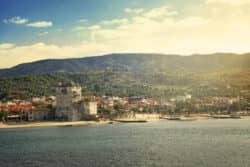About Halkidiki, Greece
Halkidiki is a peninsula that is part of the region of Central Macedonia. The coastline of Halkidiki stretches for over 500 km. The tallest mountain  in the region is Holomontas at 1,165 meters above sea level. The area is mountainous and has three peninsulas, which are referred to as “fingers” or “legs.” The three peninsulas are: Kassandra, Sithonia, and Mount Athos. The name Halkidiki was given to the peninsula by a group who were native to the region called the Chalcideans.
in the region is Holomontas at 1,165 meters above sea level. The area is mountainous and has three peninsulas, which are referred to as “fingers” or “legs.” The three peninsulas are: Kassandra, Sithonia, and Mount Athos. The name Halkidiki was given to the peninsula by a group who were native to the region called the Chalcideans.
According to Greek mythology, Egelados, the earthquake giant, is buried in Kassandra. Sithonia gets its name from Sithonas, the son of Poseidon. And Mount Athos was formed by a rock the Egelados threw at the gods.
Halkidiki is home to almost 500 beaches. The region is the leader throughout Greece in Blue Flag awards at 89. Three of Halkidiki’s marinas have also been awarded the Blue Flag.
Excavations at the Petralona Cave have shown that humans were in Halkidiki 700,000 years ago. The oldest known inhabitants were the Thracians and the Pelasgoi. In west and central Halkidiki, around the 4th century, societies such as Acanthus, Olynthos, and the ancient city of Stagira (near Olympiada) flourished. During the 5th century, Halkidiki took part in the Persian War. This would result in the siege of ancient Olynthos.
During the 9th century AD, the first monastery was built at Mount Athos. It was in the 11th century that Athos was given the name “Holy Mountain” by the Byzantine emperor. The Byzantines built many fortresses and castle to help protect the area from invasions. In 1430, the Turks would take Halkidiki from the Venetians. In 1912, Halkidiki would be set free of the Turks and become part of the province of Macedonia.
Administrative Region for Halkidiki, Greece
Central Macedonia
Area of Halkidiki, Greece
2,918 km2 (1,127 sq mi)
Population of Halkidiki, Greece
105,908
Top Attractions in Halkidiki, Greece
Poseidon’s Temple – The oldest temple of Poseidon located in Poseidi. The area was called Ancient Mende in antiquity. Excavations revealed four large buildings.
Tower of Sani – Also known as the Tower of Stavronikitas. It is located on the hill of the Sani Hotel, which is the site of where the acropolis of the ancient town is thought to have been. The tower was built in 1543 and stands 8 meters tall.
Vetrino Hill Acropolis – This prehistoric acropolis is within walking distance from Agios Nikolaos. See the settlements of Siggos and Pyrgos, which were constructed during prehistoric time. The view from the acropolis is also worth the visit.
Orange Beach – Also known as Kavourotripes, which means “crab holes.” This beach is actually many small beaches and white sand coves. The area is perfect for snorkeling and there are places to get food on site.
Cave of Petralona – Located on the west side of Mount Katsika. This cave is rich in stalactites and stalagmites. Fossils of panthers, lions, and other animals have been discovered in the cave, but the most interesting might be the human skull found in 1960 that is estimated to be 700,000 years old.
Byzantine Tower of Ouranoupolis – A little museum that explains the history of the tower. The view of the Ouranoupolis coastline is beautiful. Located in Ouranoupolis.
Ammouliani Island – Accessible by boat. The island has a number of beaches to explore. The view of the mainland, especially Mount Athos, is worth the trip to the island for.
Anthropological Museum – Located in Petralona, close to the cave. This museum houses items found in the cave including fossils and tools. This museum provides insight into the prehistoric culture of Greece.
Aristotle Park – Located in the village of Stagira. The park is dedicated to the life and work of Aristotle. The park is home to instruments and interactive games including: a water turbine, solar clock, compass, optical discs, and parabolic reflectors.
Folklore Museum of Afitos – Located in the village of Afitos in the center of the square. The museum is housed in a 19th century stone building. Exhibits include: old costumes, photographs, and tools of traditional jobs such as wine makers, carpenters, bakers, and beekeepers).

